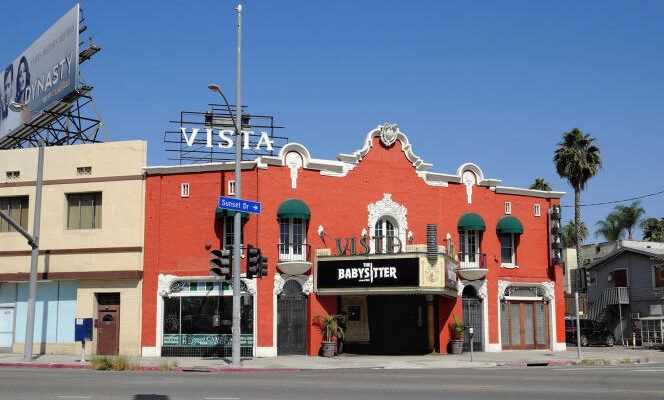A single screen
The Vista Theater opened in October 1923. Located on Sunset Drive, at the intersection of Sunset Boulevard and Hollywood Boulevard, in the Los Feliz neighborhood, near East Hollywood, this is one of the few buildings built in the 1920s in Hollywood that have remained intact. Although renovated in 1980, it has retained its original architecture, a red brick building, with exposed balconies. Inside, the cinema has 400 seats. At a time when the multiplex has become the rule, the Vista stands out with its unique screen and vintage building. A block of the past when the destruction of old buildings is in order.
An activist space
From the 1980s, the Vista Theater program X movies, then specializes in gay porn until the early 2000s. This choice is the reflection of an activist culture. In 1984, the cinema organized the premiere of The Times of Harvey Milk, Rob Epstein’s documentary about San Francisco’s first openly gay councilor. For twenty years, the establishment had programmed independent films and had also rented its room to film clubs showing exclusively 35mm films, a film widely used in classic cinema.
The film or nothing
At the beginning of July, the director Quentin Tarantino announces that he has just bought the room. It had been closed since March 2020 and the start of the pandemic. His chances of reopening dwindled over the weeks. The filmmaker had already owned, since 2007, another cinema in Los Angeles, the New Beverly – a repertory room where only 16mm and 35mm films are shown, most often from his personal collection. For the Vista, it will keep the principle of a 35mm projection, and will continue to ban digital. The cinema will nevertheless offer an exclusive program of new films, provided that a silver print is available.
A session worthy of the name
This acquisition is part of a more global reflection for Tarantino. The director, an emeritus cinephile, no longer finds the experience of the cinema room as he conceives it. In Californian multiplexes, the light remains partly on during the screenings, with spectators riveted to their mobiles, both present and absent from the film they have come to see. “It feels like a stadium, laments the filmmaker in the “Armchair Expert” podcast. These rooms have written their epitaph for a long time. It is striking how, over the years, the experience of the indoor spectator has deteriorated. “ Tarantino advocates cinemas where the standards of the meeting would be revised upwards.
